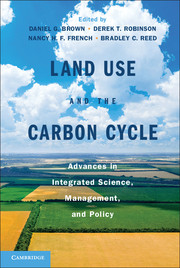Book contents
- Frontmatter
- Contents
- Chapter Authors and Affiliations
- Acknowledgments
- Acronyms
- Part I Introduction
- Part II Measurement and Modeling
- 5 Remote Sensing for Mapping and Modeling of Land-Based Carbon Flux and Storage
- 6 Atmospheric Observations and Inverse Modeling Approaches for Identifying Geographical Sources and Sinks of Carbon
- 7 Limitations, Challenges, and Solutions to Integrating Carbon Dynamics with Land-Use Models
- 8 Modeling for Integrating Science and Management
- Part III Integrated Science and Research Applications
- Part IV Land Policy, Management, and the Carbon Cycle
- Part V Synthesis and Future Directions
- Index
- Plate Section
- References
7 - Limitations, Challenges, and Solutions to Integrating Carbon Dynamics with Land-Use Models
Published online by Cambridge University Press: 05 February 2013
- Frontmatter
- Contents
- Chapter Authors and Affiliations
- Acknowledgments
- Acronyms
- Part I Introduction
- Part II Measurement and Modeling
- 5 Remote Sensing for Mapping and Modeling of Land-Based Carbon Flux and Storage
- 6 Atmospheric Observations and Inverse Modeling Approaches for Identifying Geographical Sources and Sinks of Carbon
- 7 Limitations, Challenges, and Solutions to Integrating Carbon Dynamics with Land-Use Models
- 8 Modeling for Integrating Science and Management
- Part III Integrated Science and Research Applications
- Part IV Land Policy, Management, and the Carbon Cycle
- Part V Synthesis and Future Directions
- Index
- Plate Section
- References
Summary
Introduction
Research efforts have combined land-use and land-cover change (LUCC) and carbon (C) dynamics to estimate the flux and storage of C under different land-use and land-management regimes (e.g., see Chapters 10 and 11). Ultimately, this research arena seeks to understand the C sequestration implications of different land-use change processes or futures. However, despite the need for simulation tools to produce robust predictions of C dynamics under different land-use and land-cover scenarios, there are relatively few models that integrate LUCC and C cycle dynamics. To be clear, many publications document the C balance of specific land-cover scenarios; however, there is an important distinction between modeling land-use change endogenously (such that it changes dynamically as a result of the modeled processes) and incorporating an exogenous land-cover scenario (with a prespecified set of land-cover data) in a C model.
The integration of land-use and C-cycle modeling is necessary for several reasons, most notably for the development and implementation of climate change policy (see Chapter 8). National and international science communities have emphasized the need for integrating land-use and C dynamics (e.g., the International Geosphere-Biosphere Programme [IGBP], Global Land Project [GLP], International Human Dimensions Programme on Global Environmental Change [IHDP]; see Chapter 1); however, the C and LUCC modeling communities often operate as somewhat disparate fields of research. Development of international climate negotiations and treaties, such as the Kyoto Protocol and the United Nations Framework Convention on Climate Change Good Practice Guidance for Land Use, Land-Use Change, and Forestry (UNFCCC GPG-LULUCF), relies on current estimates of C pools and fluxes, as well as our expectations for how land-use change will influence C dynamics in the future.
- Type
- Chapter
- Information
- Land Use and the Carbon CycleAdvances in Integrated Science, Management, and Policy, pp. 178 - 208Publisher: Cambridge University PressPrint publication year: 2013
References
- 4
- Cited by

